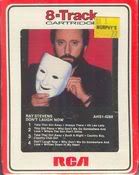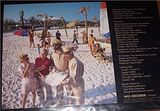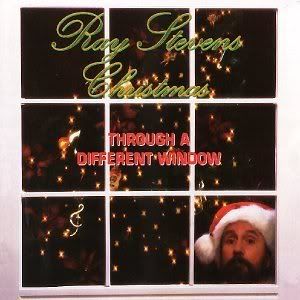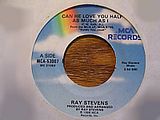 I couldn't think of a title for this blog entry. I call it "For the New Fans" even though this blog as a whole is mostly for those who are curious about Ray or discovered him on You Tube or wherever and want to know more about him from a fan's perspective. In my previous blog entry I did a Q&A session and listed several questions and answered them. I'll be including more of those Q&A's in this installment as well. For the new fans, the picture of Ray was taken in the late 1980's at some point. The picture surfaced on this collection of material and soon became an unofficial publicity picture. If you go to the Ray Stevens Backstage feature on his web-site, $4.97 per month, you'll see the full view of that picture...the tie is much longer than it appears here. I've liked the picture ever since I first saw it. There is a CD called The Legendary Ray Stevens featuring a picture taken from this same session.
I couldn't think of a title for this blog entry. I call it "For the New Fans" even though this blog as a whole is mostly for those who are curious about Ray or discovered him on You Tube or wherever and want to know more about him from a fan's perspective. In my previous blog entry I did a Q&A session and listed several questions and answered them. I'll be including more of those Q&A's in this installment as well. For the new fans, the picture of Ray was taken in the late 1980's at some point. The picture surfaced on this collection of material and soon became an unofficial publicity picture. If you go to the Ray Stevens Backstage feature on his web-site, $4.97 per month, you'll see the full view of that picture...the tie is much longer than it appears here. I've liked the picture ever since I first saw it. There is a CD called The Legendary Ray Stevens featuring a picture taken from this same session. Q: Has Ray recorded many drinking songs?
A: Surprisingly, Ray hasn't really tackled drinking songs or songs that are about alcohol. There are a few I can think of off the top of my head that he's recorded: "Sunday Mornin' Comin' Down", "One Mint Julep", "Happy Hour Is the Saddest Time of the Day", "Jack Daniels, You Lied To Me Again", "Too Drunk To Fish", and "Cooter Brown". I can't think of any others.
Q: How long has Ray been a recording artist?
A: Ray began recording in 1957 on the Prep label, a subsidiary of Capitol Records.
Q: Was there any fallout from The Shriner's Convention?
A: This refers to Ray's 1980 hit song about a hotel where a group of Shriners were spending some time. The song focuses on two Shriners and we hear a one-sided conversation between the Illustrious Potentate and Noble Lumpkin. The true names of the two men are revealed as Bubba and Coy. I did some research and found that some people who didn't get the humor of the song took offense to it. The song helped connect Ray with the charity organizations affiliated with the Shriners and since 1980 catch-phrases from that song have become part of the fan's vocabulary ever since. So, yes, there was minor grumbling and fussing about the song in 1980 but nothing loud and obnoxious...until a decade and a half later. This is when the song was discovered by an entirely new audience who shrugged off the point of the song and made it out to be a slam against Shriners, Masons, and others. The humorless in our society don't laugh at the silliness of a Shriner revving up a motorcycle engine in the wee hours of the morning or wonder how the motorcycle got up on the diving board. The humorless don't understand why Coy behaves the way he does and they back up their position by saying "no Shriner acts like that!!". Well, of course, that's the whole point of the song. It's not meant to be a look at a real Shriner convention. The humorless have no reason to even give their opinion of a comedy song since they have no sense of humor.
Q: How many labels has Ray recorded for?
A: A lot of people who aren't really into music don't pay much attention to record labels or anything like that. A lot of record companies and subsidiaries down through the years have made a lot of money off of Ray's recordings. There once was a time when the subsidiaries of Mercury Records would issue a Ray Stevens compilation album every few years...featuring the same material...over and over. Barnaby Records was treated much the same way. The hit recordings for that label have appeared on labels ranging from RCA to Curb to Varese Sarabande and all points in between. As far as official record labels and not just those who've issued his material, well, here's the rundown...I'm not 100% accurate on some of the years...
Prep: 1957
Capitol: 1958
NRC: 1959-1961
Mercury: 1961-1963
Monument Records: 1966-1970
Barnaby Records: 1970-1975
Warner Brothers: 1976-1979
RCA: 1980-1982
Mercury: 1983
MCA: 1984-1989
Curb: 1990-1994
Clyde Records: 1994-1996
MCA: 1997-1998
Clyde: 1999-2002
Curb*: 2002-
Clyde*: 2004-
Ray's material, starting in 2002, is often distributed by Curb Records even though the material is originally released through his own label, Clyde. Ray had returned to Curb Records in 2002 and since then they've distributed nearly everything Ray has issued whether it's CD's or DVD's. Curb, I assume, picks and chooses what they want to distribute to shopping stores.
Q: Why did Ray begin making music videos?
A: As far as I know Ray used to have videos run on a big screen at his Branson, Missouri theater and according to Ray the audiences were laughing even louder while the video clips were being shown above the stage. Ray then decided to put together a music video collection and sell it exclusively at his theater. This led to a full-blown nationwide collection, Comedy Video Classics, in 1992. After it's success throughout the summer, fall, and winter via television advertising it moved into shopping stores and sold well over half a million which was unheard of for a home video release. This led Ray to do more and more with home video and later, DVD. His output was at it's peak in the mid 1990's, though, but every so often something different from Ray on DVD will become available.
Q: How many TV appearance has Ray made?
A: A rough estimate would be hundreds. Remember, Ray was once marketed as a pop artist and because of this he appeared on quite a number of teen-idol programs both locally and nationally during the 1960's and into the early 1970's. Although Ray is not among the ones cited as being a teen-idol he definitely had a teenage following, particularly in the late '60s and early '70s. He then became more and more popular with the adult audience that listened to pop music and more of his low charting pop songs were reaching the Top-40 on the Adult-Contemporary format and he began appearing on shows with a slightly older audience. As Ray approached 40 he was considered a country artist and this is why in the mid to late '70s he was featured on just about every country music television show on the air. He had appeared on country music programs before but the late '70s was the big push turning Ray into a mainstream country artist. After 1980 Ray's main exposure came from Hee-Haw and in 1983 when The Nashville Network debuted he began making several appearances annually on the various programs on that network. Ray also appeared on a week's worth of episodes on the soap opera, Texas, the game show Hollywood Squares during the John Davidson era, in addition to an episode of The Fall Guy.














